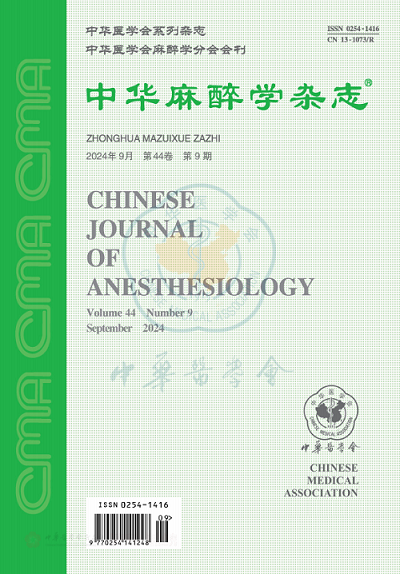Effects of thoracic paravertebral nerve block at different time points on postoperativelong-term quality of life in patients undergoing thoracoscopic radical resection of lung cancer
Q4 Medicine
引用次数: 0
Abstract
Objective To evaluate the effect of thoracic paravertebral nerve block (TPVB) at different time points on postoperative long-term quality of life in the patients undergoing thoracoscopic radical resection of lung cancer. Methods One hundred and fifty patients of both sexes, aged 25-64 yr, with body mass index of 18-24 kg/m2, of American Society of Anesthesiologists physical status Ⅰor Ⅱ, scheduled for elective radical resection of lung cancer, were divided into 3 groups (n=50 each) by a random number table method: preoperative TPVB group (P1 group), TPVB at the end of operation group (P2 group) and preoperative TPVB combined with TPVB at the end of operation group (P3 group). In group P1, TPVB was performed at T4, 6 points on the affected side under ultrasound guidance before anesthesia induction, and 0.5% ropivacaine 10 ml was injected in total.In group P2, TPVB was performed at T4, 6 points on the affected side under ultrasound guidance at the end of operation, and 0.5% ropivacaine 10 ml was injected in total.In group P3, TPVB was performed at T4, 6 points on the affected side under ultrasound guidance before anesthesia induction and at the end of operation, and 0.5% ropivacaine 10 ml was injected each time.The analgesia pump was connected at the end of operation in three groups.The patients were followed up after operation, and 5 ml solution extracted from the analgesic pump was intravenously injected when VAS score was greater than or equal to 4.The occurrence of postoperative chronic pain in the 3 groups was recorded though telephone follow-up at 6 and 12 months after surgery, and the effect of pain on daily life and treatment measures were scored.A concise health-related quality of life scale was used to evaluate patients′ quality of life, and the physical and mental health scores were calculated. Results There was no significant difference in the incidence of chronic pain at 6 and 12 months after surgery among the three groups (P>0.05). The physical and mental health scores were significantly decreased at 12 months after surgery than at 6 months after surgery in the three groups (P<0.05). Compared with P1 and P2 groups, the scores of effect of pain on daily life and treatment measures were significantly decreased, and the physical and mental health scores were increased at 12 months after surgery in group P3 (P<0.05). Conclusion The combination of preoperative TPVB and TPVB at the end of operation can effectively improve postoperative long-term quality of life in the patients undergoing thoracoscopic radical resection of lung cancer. Key words: Nerve block; Thoracoscopes; Lung neoplasms; Quality of life不同时间点胸椎旁神经阻滞对癌症胸腔镜根治术患者术后长期生活质量的影响
目的评价不同时间点胸椎旁神经阻滞(TPVB)对癌症胸腔镜根治性切除术后长期生活质量的影响。方法采用随机数表法,将美国麻醉医师学会身体状况Ⅰ或Ⅱ级、年龄25~64岁、体重指数18~24kg/m2的癌症择期根治性切除患者150例分为术前TPVB组(P1组),术后TPVB组(P2组),术前TPVB联合TPVB治疗组(P3组)。P1组在麻醉诱导前超声引导下于T4、患侧6点进行TPVB,共注射0.5%罗哌卡因10ml。P2组在T4行TPVB,术后在超声引导下于患侧6点进行,共注射0.5%罗哌卡因10ml。P3组于T4,麻醉诱导前及手术结束时,在超声引导下于患侧6个点进行TPVB,每次注射0.5%罗哌卡因10ml。三组患者术后均连接镇痛泵。术后随访,VAS评分大于或等于4时,静脉注射镇痛泵提取的5ml溶液。术后6个月和12个月,通过电话随访记录3组术后慢性疼痛的发生情况,并对疼痛对日常生活的影响和治疗措施进行评分。使用简明的健康相关生活质量量表来评估患者的生活质量,并计算身心健康评分。结果三组患者术后6个月和12个月的慢性疼痛发生率差异无统计学意义(P>0.05),术后12个月三组患者的身心健康评分均显著低于术后6月(P<0.05),疼痛对日常生活的影响和治疗措施的得分显著降低,结论术前TPVB与术后TPVB联合应用可有效提高癌症胸腔镜根治术患者术后长期生活质量。关键词:神经阻滞;胸腔镜;肺肿瘤;生活质量
本文章由计算机程序翻译,如有差异,请以英文原文为准。
求助全文
约1分钟内获得全文
求助全文

 求助内容:
求助内容: 应助结果提醒方式:
应助结果提醒方式:


